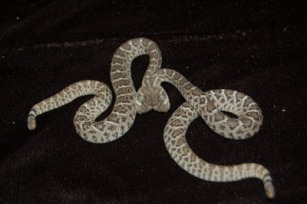Conjoined rattlesnakes successfully separated
TUCSON, AZ - A wild surgery took place Thursday when conjoined rattlesnakes underwent surgery to be separated in order to survive. The conjoined snakes are an anomaly rarely seen in the wild.
The snakes, which were connected just below the head, were found at a construction site and brought to the Arizona Sonora Desert Museum. The museum enlisted local vet Dr. Jim Jarchow to attempt to separate the animals.
The snakes, which were connected just below the head, were found at a construction site and brought to the Arizona Sonora Desert Museum. The museum enlisted local vet Dr. Jim Jarchow to attempt to separate the animals.
"It's my job to improve their quality of life and survive and function as they normally would," Dr. Jarchow says.
The Desert Museum said that it is extremely rare for snakes to be found like this in the wild.
"I've been working with reptiles for 20 years and this is the first time I've seen them in the flesh," says Stephan Poulin with the Desert Museum.
The surgery took about 45 minutes, and after three weeks of living together, they quickly became two separate snakes.
Originally it was thought the snakes were connected by soft tissue only, but during the surgery Dr. Jarchow found that the snakes were actually connected by bone.
"They shared part of the top of two vertebrae and we had to cut through the connection," he says.
Recovery from the surgery will take several months, after which the snakes will be put on display at the Desert Museum. The snakes were moving on their own just a few minutes after surgery and are expected to make a full recovery.
"They should live a healthy, complete separate life from each other," says Poulin.
And even though these twins will now live their own lives, they'll always share a special
resource from... Conjoined rattlesnakes successfully separated - KVOA News 4, Tucson, Arizona -
The Desert Museum said that it is extremely rare for snakes to be found like this in the wild.
"I've been working with reptiles for 20 years and this is the first time I've seen them in the flesh," says Stephan Poulin with the Desert Museum.
The surgery took about 45 minutes, and after three weeks of living together, they quickly became two separate snakes.
Originally it was thought the snakes were connected by soft tissue only, but during the surgery Dr. Jarchow found that the snakes were actually connected by bone.
"They shared part of the top of two vertebrae and we had to cut through the connection," he says.
Recovery from the surgery will take several months, after which the snakes will be put on display at the Desert Museum. The snakes were moving on their own just a few minutes after surgery and are expected to make a full recovery.
"They should live a healthy, complete separate life from each other," says Poulin.
And even though these twins will now live their own lives, they'll always share a special
resource from... Conjoined rattlesnakes successfully separated - KVOA News 4, Tucson, Arizona -
Python Hunting Allowed in Florida
July 21, 2009
For the first time, Florida is allowing select hunters
to kill pythons in the wild. The non-native snakes are believed to
number in the tens of thousands and are killing endangered species, experts say.
The state of Florida has issued permits to certain hunters allowing them to catch pythons,
which are wreaking havoc with native flora and fauna in the Everglades National Park.
The Florida Fish and Wildlife Conservation Commission is allowing a few
permitted snake experts to begin hunting,trapping and killing the snakes.
The python population in Florida and throughout the Everglades has exploded
over the past decade- perhaps numbering as high as 150,000.
Large numbers of pythons escaped during Hurricane Andrew in 1992 ,
and scientists believe some pet owners have freed their snakes once they became too big.
And they are a threat to endangered species.
David Halleck, Biologist: "This is a serious problem,
and as you know the Everglades has a number of threatened and endangered species, federally listed and state listed,
And we're trying to restore the Everglades and bring those species back.
And here we have an invasive organism that's very effective at eating all the species that we're trying to restore.
" An official with the Florida Fish and Wildlife Conservation Commission said ,
the hunt is just the beginning of an eradication program.
Rodney Barreto, Chairman, Florida Fish and Wildlife Conservation Commission: "Once this thing's has a little value, someone's going to come together andfigure out a trap, a bait,or something that's going to help us really eradicate this.
" Burmese pythons are native to southeast Asia, but they survive easily in Florida's warm, moist climate.
View All News Videos
Python Bursts After Eating Gator
Unfortunately for a 13-foot (4-meter) Burmese python in Florida's Everglades
National Park, eating the enemy seems to have caused the voracious reptile to bust a gut literally.
Wildlife researchers with the South Florida Natural Resources Center found the dead,
headless python in October 2005 after it apparently tried to digest a 6-foot-long (2-meter-long) American alligator.
The mostly intact dead gator was found sticking out of a hole in the
midsection of the python,
and wads of gator skin were found in the snake's gastrointestinal tract.
The gruesome discovery suggests that the python's feisty last meal might have been simply too much for it to handle.
An alternative theory will be put forth in a September 16 Explorer episode on the National Geographic Channel.
(National Geographic News is part of the National Geographic Society,
which is part owner of the National Geographic Channel.)
An animated recreation of the python-alligator battle suggests that the python might have survived its massive meal,
but that a second gator came to the rescue and bit off the snake's head.
The force of the tussle, the new theory says, is what caused the python to burst. But even scientists associated with the show aren't so sure the new theory holds water.
Wayne King, reptile curator at the Florida Museum of Natural History in Gainesville,cites the relatively clean decapitation of the snake.
"Alligators, they don't bite off a piece,"he told McClatchey Newspapers. "They grab hold, then they roll and spin.
If one grabs you by the arm, normally they wrench the arm off,
or if they grab you by the buttocks, they'll rip away a chunk of meat.
" Clashes between alligators and pythons have been on the rise in the Everglades for the past 20 years.
Unwanted pet snakes dumped in the swamp have thrived,
and the Asian reptile is now a major competitor in the alligator's native ecosystem.
(See "Huge, Freed Pet Pythons Invade Florida Everglades.")
"Clearly if [pythons] can kill an alligator, they can kill other species," Frank Mazzotti,
a University of Florida wildlife professor, told the Associated Press.
"There had been some hope that alligators can control Burmese
pythons. …
This [event] indicates to me it's going to be an even draw."
resources from.... National Geographic - Inspiring People to Care About the Planet


